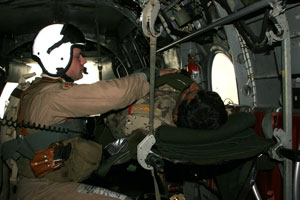|
Medical Education Division |
Operational Medicine 2001
Field Medical Service School
Student Handbook

FIVE
PARAGRAPH ORDER
“Remember
gentlemen, an order that can be misunderstood will be misunderstood.
An order should contain everything that a commander cannot do himself,
but nothing else.” Count
Helmut von Moltke
TERMINAL LEARNING OBJECTIVES
ENABLING LEARNING OBJECTIVES
OUTLINE A.
INTRODUCTION
B.
CHARACTERISITICS
OF ORDERS. Effective combat orders are characterized by:
C.
TYPES
OF COMBAT ORDERS.
D.
FIVE
PARAGRAGH ORDER. A five paragraph order gives subordinates the essential
information needed to carry out the operation.
It sets forth the Situation,
the Mission, the plan and
method of Execution, Administration
and Logistics, and Command and
Signal information. This format is
commonly referred to and remembered by the acronym SMEAC. 1. Orientation. Prior to issuing the order, the unit leader orients his subordinate leaders to the planned area of operation using a terrain model or operational graphics. The purpose of the orientation is not to discuss the details of the order or terrain model, but rather to simply orient subordinates to their map and the terrain model prior to the issuance of the order.
a.
Enemy
Forces. This subparagraph contains essential information concerning
the enemy’s composition, disposition, location, capabilities, limitations, and
recent activities of the enemy. Use
the acronym SALUTE: 1)
Size –
enemy squad, platoon, ... 2)
Activity – enemy digging in, bivouacking, … 3)
Location – six digit grid if possible. 4)
Unit –
3rd Centralian Infantry, 7th Iraqi Armor, … 5)
Time
– when the enemy was last observed. 6)
Equipment – Soviet small arms, machine guns, mortars, … b.
Friendly
Forces. This subparagraph contains essential information concerning
the mission of the next higher unit, location and mission of adjacent units, and
mission of non-organic supporting units. Information
in this subparagraph can be remembered with the acronym HAS: 1)
Higher 2)
Adjacent 3)
Supporting c.
Attachments
and Detachments. Non-organic units attached (+) and/or organic units detached
(-) from the unit. 3. MISSION. This paragraph provides a clear and concise statement of what the unit is to accomplish. The mission statement is the heart of the order and should answer the following five questions (the five W’s): a.
Who b.
What c.
When d.
Where e.
Why
a.
Concept
of Operations. This is a general explanation of the tactical plan.
It includes a brief scheme of maneuver from start to conclusion, type of
attack, and fire support plan. b.
Tasks. The specific missions to be accomplished by each subordinate
element of the unit will be listed in a separate numbered subparagraph.
It is the subordinate’s unit mission statements. c.
Coordinating
Instructions. The specific instructions and tasks that apply to two of more
units. Information given includes
order of movement, planned combat formations, tactical and fire control measures
(i.e., phase lines, checkpoints), and any other tasks that pertain to the
mission.
a.
Signal. Gives signal instructions for the operation such as
frequencies, call signs, pyrotechnics, challenge and password, and brevity
codes. b.
Command. Identifies the chain of command and their location (including
the corpsman) before, during, and after the operation. REFERENCE: Marine
Rifle Squad, FMFM 6-5 Field Medical Service School
Approved for public release; Distribution is unlimited. The listing of any non-Federal product in this CD is not an endorsement of the product itself, but simply an acknowledgement of the source. Operational Medicine 2001 Home · Military Medicine · Sick Call · Basic Exams · Medical Procedures · Lab and X-ray · The Pharmacy · The Library · Equipment · Patient Transport · Medical Force Protection · Operational Safety · Operational Settings · Special Operations · Humanitarian Missions · Instructions/Orders · Other Agencies · Video Gallery · Phone Consultation · Forms · Web Links · Acknowledgements · Help · Feedback
*This web version is provided by The Brookside Associates Medical Education Division. It contains original contents from the official US Navy NAVMED P-5139, but has been reformatted for web access and includes advertising and links that were not present in the original version. This web version has not been approved by the Department of the Navy or the Department of Defense. The presence of any advertising on these pages does not constitute an endorsement of that product or service by either the US Department of Defense or the Brookside Associates. The Brookside Associates is a private organization, not affiliated with the United States Department of Defense. |

